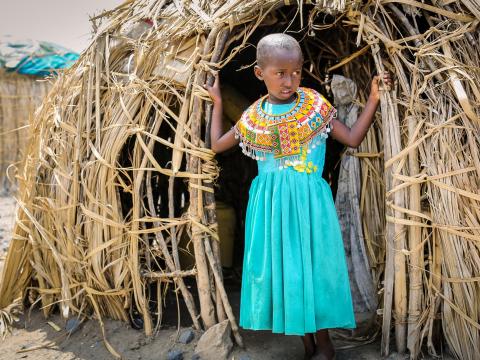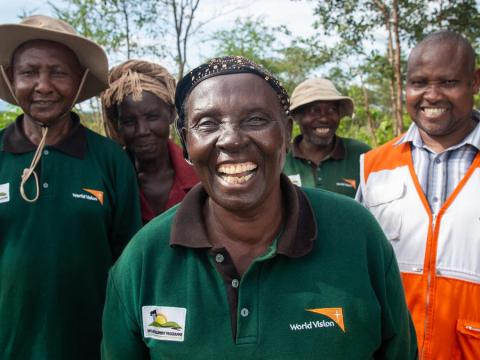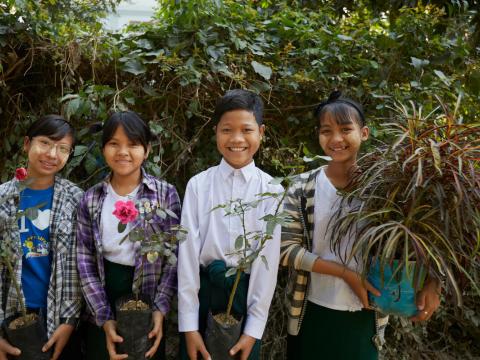
Why we need an IPCC Special Report centred on children and climate change
A call to action to governments and the IPCC from the world’s leading child-focused agencies.
7 March, 2022
The recent 6th assessment report of the global body of scientists that make up the Intergovernmental Panel on Climate Change (IPCC) has provided stark reading on the global extent of climate change impact, the limitations of our adaptation responses, and the resulting loss and damage. Such reports provide the core evidence base that guides policy, investment and business decisions, framing the narratives driving human responses to the climate crisis. However, despite being the most impacted , children remain absent from many of the critical discussions and decisions. This includes IPCC reports, meaning they at best partially reflect the needs and voices of children, a signal passed on to decision-making globally.
Children’s lives are profoundly affected by climate change
The actions we take, or fail to take, about climate change will affect children throughout their lives. According to UNICEF, almost every child (>99 %) is currently exposed to at least one climate or environmental shock. Recent research published in the journal Science suggests that children born in 2020 will live through seven times as many heatwaves, more than twice as many droughts, and three times as many crop failures as their grandparents. The analysis, also shared in the Born Into the Climate Crisis Report shows these impacts are not felt equally, with lower income countries most impacted, with significant impacts felt even if warming can be limited to 1.5 degrees.
The IPCC AR6 report does note some impacts of climate change on health and nutrition, educational attainment and long-term adverse socio-economic effects on children, but it misses the opportunity to systematically set out the unique challenges of the climate crisis for under 18s. Compared to adults, children require more food and water per unit of their body weight, are less able to survive extreme weather events, and are more susceptible to temperature changes and diseases. Climate harm in childhood lasts throughout the life course, and perpetuates and deepens inequality and poverty across generations. These impacts are even more pronounced for those with disabilities and for girls, who are often the first to be taken out of school during crises, are at greater risk of sexual violence following disasters, while child marriage can increase in places where climate change is threatening the viability of agricultural livelihoods.
“Where a choice has to be made between which of two school-going children would miss school to queue for aid, it is always the girl child who does the queuing because normally they have responsibility for cooking and general household duties.” - Quote from research by adolescent girls from Chiredzi, Zimbabwe
The services children rely on are not resilient
The IPCC report flags the insufficiency of current levels of adaptation. The children in the poorest communities, with fewest resources, and the least responsibility for emissions are facing the most immediate dangers. Concerningly, the sectors and services most critical to children’s development and survival - including water and sanitation, education, health, nutrition, social policy and child protection- are often inadequate, and not robust enough to protect them in the face of climate change.
Recognising the significant impacts on children’s life chance, global climate change responses must be considered in the context of multiple fields that affect the specific needs of children. Even while we push for the world to take decisive mitigation action, we know major impacts are already ‘baked in’, even if we can limit warming to 1.5 degrees. We therefore must adequately and urgently invest in adaptation, across all child-relevant sectors, and consider how to provide adequate mechanisms to address loss and damage. Ensuring the resilience of both child-focused services and livelihood opportunities must go hand in hand with low carbon transitions that are fair and inclusive.
“The government should focus more on how to help these affected children and to ensure continuous education without disruption. If the decision makers take action to provide these children with devices and ensure continuous access to internet, they can continue their studies even during disastrous periods.” Dilmani, a 15 year old girl from Sri Lanka
Children’s needs and voices need to be at the centre of climate science, policy and finance
We need to move beyond simply recognising differentiated impacts and towards ensuring that children and young people have opportunities, resources, skills and a safe space to engage in and influence climate policy processes locally, nationally and globally. They are not only victims, but the most critical clients for the policies and solutions being devised. In recent years, young people’s voices have taken centre stage in protests from the streets, and the UN climate negotiations now recognises a formal space for Youth under its YOUNGO group.
However, the voices of under 18s are less frequently given space. Climate justice is inextricably linked to children's rights, including their rights to participate meaningfully in decisions that affect them. This means breaking down the barriers to participation that children and young people themselves readily identify, both their own capacities and the enabling environment to listen and take on board their views. Recent reviews showed that national climate policies are currently failing to address children and their needs. As countries revise and implement their climate action/adaptation plans, there is an opportunity to engage and consult children and young people (including those under 18 years of age) in the process. And for children to effectively engage, they must be informed about the latest science.
“I have owned many good skills which will contribute for my future career such as working by team, making decision, making presentation, and teaching others. We have also shared our learning with our families”. Radnaakhand, a 15 year old girl from Mongolia, talking about membership of the Junior Rescuer Club.
The IPCC, and the governments of the world that commission and frame its reports, have an important role to play in the process. Future reports should give greater emphasis to children, reflecting the depth of available science as well as the needs of children, and there should be versions of these reports targeted to younger age groups. Governments and the IPCC can also demonstrate the importance of children and future generations by commissioning an IPCC Special Report on Children and Climate Change, and engaging with children in framing its content.
Ultimately, our present development paradigm is failing millions of children globally. Climate change action is an opportunity for transformational change that frames decisions on low carbon transitions and adapting to climate change around the needs of current and future generations, whilst giving voice to those who have the most at stake - our children.
Written by Dr Thomas Tanner, SOAS University of London in collaboration with the global climate leads of five largest child-centred NGOs/agencies in the world: Gautam Narasimhan (UNICEF), Yolande Wright (Save the Children), and Jason Garrett (World Vision International). Additional contributions from: Yukiko Yamada (World Vision International).

